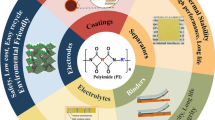Abstract
This study presents an investigation of the effects of adding extra nitro group substituents to N-(3,5-dimethyl-2,4,6-trinitrophenyl)-1H-1,2,4-triazol-3-amine (HEM-II) on its thermal and chemical stability as well as its explosive performance. An analysis of the thermal stabilities of HEM-II and HEM-II-based molecules based on an investigation of the binding energy per atom for each molecule was performed. The values of the gap between the highest occupied molecular orbital (HOMO) and the lowest unoccupied molecular orbital (LUMO) as well as those of the chemical hardness and softness for HEM-II and the HEM-II-based molecules were studied to determine the chemical stabilities of these molecules. The detonation velocity and oxygen balance of each HEM-II-based molecule were investigated to elucidate its explosive properties. The results of our investigation show that the presence of additional nitro groups suppresses the tendency of the new HEM-II-based explosive material to react with other materials, improves its explosive properties (strength), decreases the likelihood that it will degrade, and enhances its toxicity and thermal stability. We also found that zero-point correction does not need to be performed when molecules with different substituents are investigated and compared.

Similar content being viewed by others
References
Cooper P, Kurowski S (1996) Introduction to the technology of explosives. Wiley–VCH, New York
Maienschein JL (2014) Research topics in explosives—a look at explosives behavior. J Phys Conf Ser 500(052027):1–9
Schmidt RD, Lee GS, Pagoria PF, Mitchell AR, Gilardi R (2001) Technical report UCRL-ID-148510 TRN: US200322%%384. Lawrence Livermore National Lab., Livermore
Nambiar PR, Verneker VR, Jain SR (2005) Explosive sensitivity of methylammonium perchlorates. J Therm Anal Calorim 8(1):15–26
Iyer S (1984) Explosive desensitization studies via chemical group modification. II. 3,5-Diamino- and 3,5-dichloro-2,4,6-trinitrotoluene(1). J Energ Mater 1–2:151–158
Bellamy AJ, Ward SJ, Golding P (2002) Synthesis of ammonium diaminopicrate (ADAP), a new secondary explosive. Propellants Explos Pyrotech 27(2):59–61
Bi-dong W, Wang S, Yang L, Zhang T, Zhang J, Zhou Z, Yu K (2011) Preparation, crystal structures, thermal decomposition and explosive properties of two novel energetic compounds M(IMI)4(N3)2 (M = CuII and NiII, IMI = imidazole): the new high–nitrogen materials (N > 46%). Eur J Inorg Chem 16:2616–2623. doi:10.1002/ejic.201100054
Tamuliene J, Sarlauskas J, Bekesiene S, Kleiza V (2014) Investigation of stability of N-(2,4,6-trinitrophenyl_-1H-1,2,4-triazol-3-amine. In: Proc 9th Int Conf ITELMS 2014, Panevezys, Lithuania, 22–23 May 2014, pp 260–262
Tamuliene J, Sarlauskas J, Bekesiene S (2015) Influence of substitutes to the stability and energetic propeties of N-(2,4,6-trinitrophenyl)-1H-1,2,4-triazol-3-amine. In: Proc 10th Int Conf ITELMS 2015, Panevezys, Lithuania, 21–22 May 2015, pp 266–269
Jeremić R, Bogdanov J (2012) Development of a new model for the calculation of the detonation parameters of high explosives. J Serb Chem Soc 77(3):371–380. UDC 662.21:662.215.2:519.87
Frisch MJ et al. (2004) Gaussian 03, revision C.02. Gaussian, Inc., Wallingford
Lothrop WC, Handrick GR (1949) The relationship between performance and constitution of pure organic explosive compounds. Chem Rev 44(3):419–445
Yang W, Parr RG (1985) Hardness, softness, and the Fukui function in the electronic theory of metals and catalysis. Proc Natl Acad Sci USA 82:6723–6726
Allen MJ, Tozer DJ (2002) Eigenvalues, integer discontinuities and NMR shielding constants in Kohn–Sham theory. Mol Phys 100:433–439
Tozer DJ (2003) Relationship between long-range charge-transfer excitation energy error and integer discontinuity in Kohn–Sham theory. J Chem Phys 119:12697–12699
Tozer DJ, Proft FD (2005) Computation of the hardness and the problem of negative electron affinities in density functional theory. J Phys Chem A 109:8923–8929
Zhang G, Musgrave CB (2007) Comparison of DFT methods for molecular orbital eigenvalue calculations. J Phys Chem A 111:1554–1561
Kaya S, Kaya C (2015) New equation based on ionization energies and electron affinities of atoms for calculating of group electronegativity. Comput Theor Chem 1052:42–46
Toropov AA, Rasulev BF, Leszczynski J (2008) QSAR modeling of acute toxicity by balance of correlations. Bioorg Med Chem 16:5999–6008
Turker L (2010) Velocity of detonation-a mathematical model. Acta Chim Slov 57:288–296
ACD (2015) Structure Elucidator. Advanced Chemistry Development, Inc., Toronto. www.acdlabs.com
Eaton PE, Gilardi RG, Zhang M (2000) Polynitrocubanes: advanced high-density, high-energy materials. Adv Mater 12(15):1143–1148
Politzer P, Murray JS (2015) Impact sensitivity and the maximum heat of detonation. J Mol Model 21:262
Keshavarz MH (2008) Estimating heats of detonation and detonation velocities of aromatic energetic compounds. Propellants Explos Pyrotech 33:448–453
Acknowledgments
This work was conducted within the framework of the LMA scientific project “A theoretical and experimental investigations of new potentially explosive materials using quantum mechanical methods (NSPROG-I4).” The authors are thankful for the high-performance computing resources provided by the Information Technology Open Access Center of Vilnius University.
Author information
Authors and Affiliations
Corresponding author
Rights and permissions
About this article
Cite this article
Tamuliene, J., Sarlauskas, J. & Bekesiene, S. Modeling and investigation of new explosive materials based on N-(3,5-dimethyl-2,4,6-trinitrophenyl)-1H-1,2,4-triazol-3-amine. J Mol Model 23, 228 (2017). https://doi.org/10.1007/s00894-017-3399-4
Received:
Accepted:
Published:
DOI: https://doi.org/10.1007/s00894-017-3399-4




